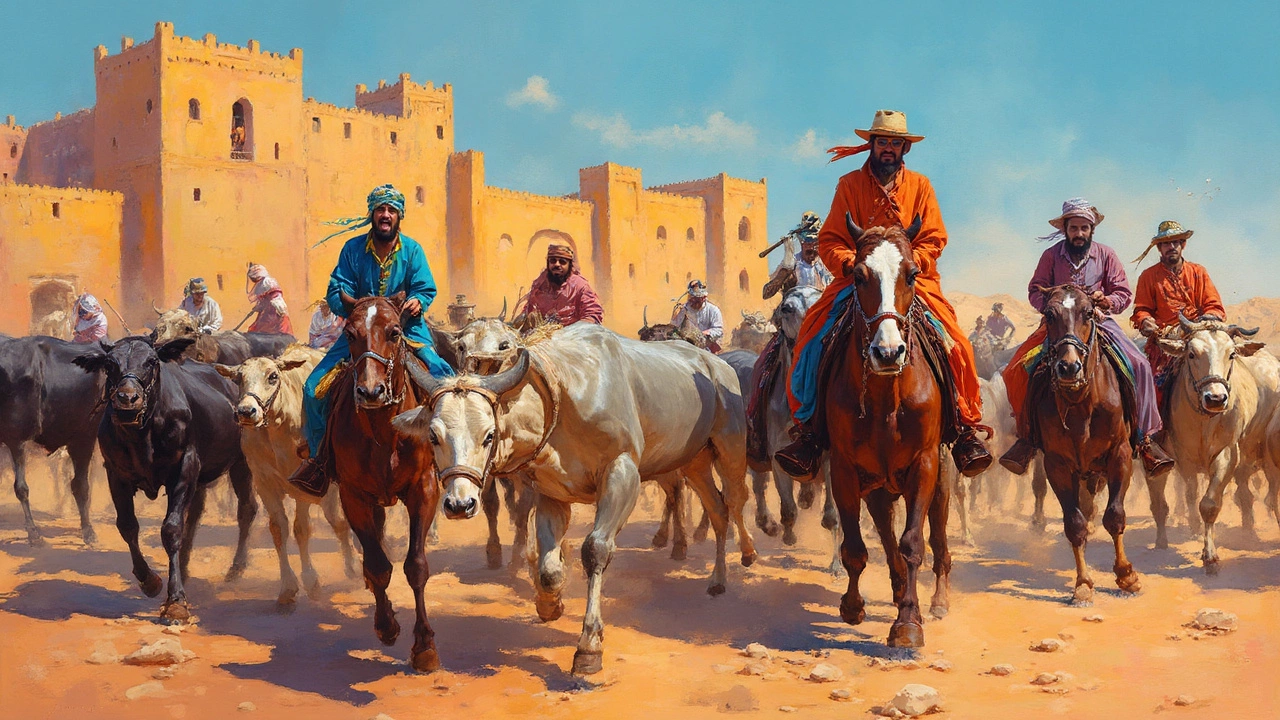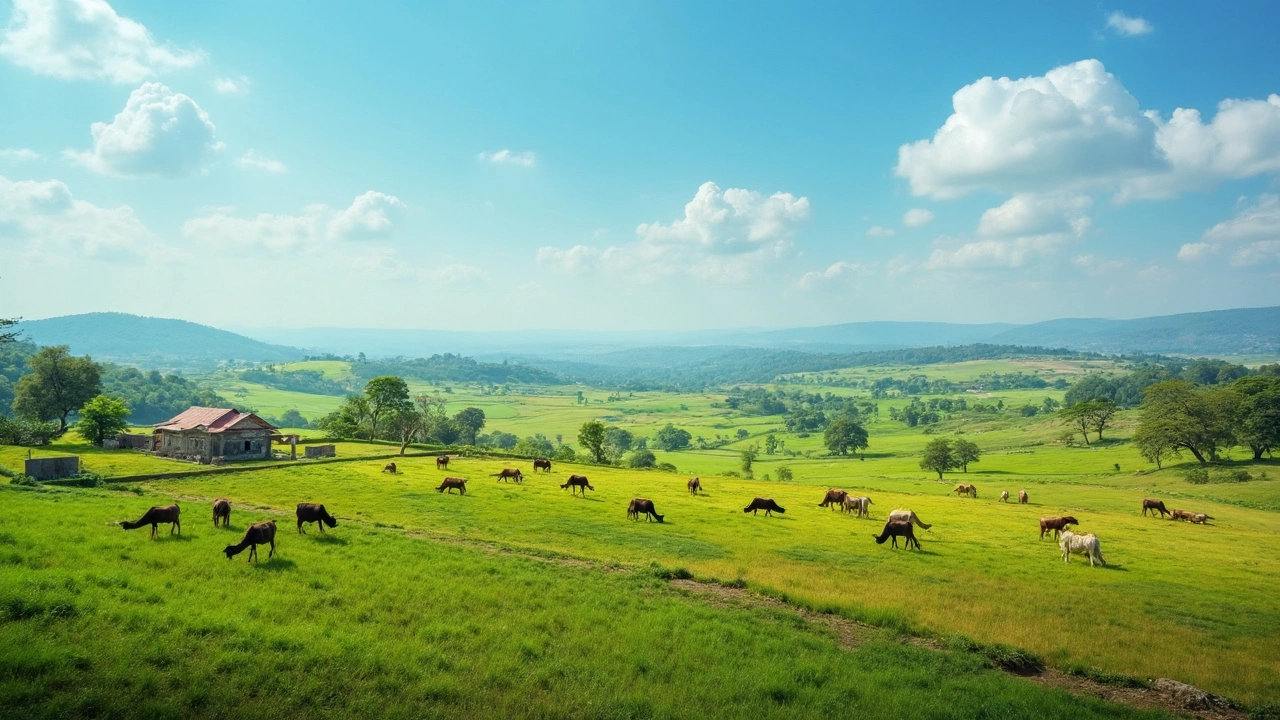Buying a ranch sounds like an adventure, right? But how many acres do you really need? Turns out, there isn't a simple answer. Ranch sizes can vary wildly depending on what you want to use it for and where it's located. Some ranches are a cozy 10 acres, perfect if you're thinking of a small hobby farm or a weekend getaway. Others can stretch into thousands of acres, especially if you're diving into cattle ranching or looking for an investment property.
Most importantly, your perfect ranch size depends on your goals. If you're in it for a business with livestock, you'll need more land—think hundreds of acres. A retreat with some privacy? A lot less. And of course, your wallet will have a say in this too. In this article, we're breaking down what goes into deciding how many acres your future ranch might need.
- Defining a Ranch
- Factors Affecting Ranch Size
- Comparing Ranch Sizes Globally
- Purpose and Acreage Requirements
- Tips for Choosing the Right Ranch Size
Defining a Ranch
When people talk about a ranch, they typically picture a vast stretch of land, often in rural settings, dotted with grazing cattle or picturesque horses. But is that all there is to a ranch? Let's demystify what makes a piece of land a ranch.
First off, a ranch is primarily an operation where the main commercial activity is the raising of livestock. That doesn't mean it can't be used for other activities like farming or even recreation, but livestock is the big one. A ranch size, in terms of acres, can change significantly based on what you're raising and where you're doing it.
Livestock and Land
The type of livestock can influence how much land you need. For instance, cattle need more room than sheep or goats. A general rule of thumb is about 1.5 to 2 acres per cow-calf pair, so a cattle ranch might need hundreds of acres. Smaller animals or different settings, like lamb or alpaca ranching, can get by with less space.
Location, Location, Location
Where your ranch is located plays a huge role. In dry, arid regions, you'll need more land since the vegetation is sparse and livestock need more space to graze. Contrastingly, in areas with rich, plentiful grassland, you might require less land for the same number of animals.
The Hobby Ranch
Then there’s the hobby ranch, often smaller and not necessarily profit-driven. These might be around 10 to 50 acres and are more about lifestyle than business. It's where owners might have a mix of animals, a big garden, and undoubtedly, some peace and quiet.
Below is a simple breakdown of different ranch activities and their typical acreage requirements:
| Ranch Type | Typical Acreage |
|---|---|
| Cattle Ranch | 500+ acres |
| Sheep Ranch | 100+ acres |
| Hobby Ranch | 10-50 acres |
In a nutshell, a ranch is more than just a chunk of land. It's defined by its purpose, the type of livestock, and the local conditions—all of which dictate the acres you might need.
Factors Affecting Ranch Size
Deciding on the right ranch size isn't just about wanting a bigger piece of land. There are a bunch of practical things that come into play. Check out some of the big factors you should consider.
Purpose of the Ranch
Why do you want the ranch? That's a biggie. If you're aiming for cattle ranching, you definitely need more land to give those cows the space they need to roam and graze. But if you're dreaming of a peaceful retreat or hobby farm, a smaller parcel might be just fine.
Location Matters
The place where the ranch sits is crucial. In some areas, a smaller number of acres can cost a bomb if it's in a prime real estate zone. Think about whether the land is remote or near useful amenities. If you're planning to sell later, consider areas with higher appreciation rates.
Local Zoning Laws
Every place has its rules. Local zoning and land-use regulations might restrict what you can do on your ranch. Before you finalize a purchase, dig into these laws. They could dictate the minimum or maximum acreage for specific uses.
Budget Constraints
Your wallet will likely have the final say. Ranches can range from a few thousand to millions of dollars. Set a budget that considers not only the land purchase but also development and maintenance costs. That way, you're not left in the lurch post-purchase.
Resale Value
Consider what future buyers might want. Larger ranches typically attract those interested in commercial ventures, while smaller ones might appeal to families or retirees. Think about who might want your property down the road and choose the size accordingly.
Here's a quick look at how different factors can influence ranch sizes:
| Factor | Impact on Size |
|---|---|
| Purpose | Defines if you need 10-1000 acres |
| Location | Remote less expensive, urban costs more |
| Zoning Laws | Might limit acreage for certain uses |
| Budget | Sets realistic size scale |
| Resale Value | Bigger may appeal more commercially |
Got all that? These factors will give you a better picture of what size that ranch of yours should be. Make sure you weigh each one carefully when you're on the hunt for that ideal piece of land.

Comparing Ranch Sizes Globally
When it comes to ranches, the world offers a grand variety in size. Let's kick off with the United States, where everything's bigger, they say. In states like Texas and Montana, it's not uncommon to stumble upon ranches sprawling over 20,000 acres. A ranch of this size might include rolling pastures, multiple water resources, and land suitable for livestock and agriculture. It's perfect for serious ranchers looking to enter the world of large-scale cattle operations.
Heading south to Australia, the land of wide-open spaces, ranches here—known as 'stations'—can dwarf their American counterparts. The biggest, Anna Creek Station, stretches over a jaw-dropping 5.9 million acres, functioning more like a small territory! These ranches are integral to Australia's beef industry and require both extensive management and infrastructure due to their massive sizes.
On the other hand, in Europe, ranch sizes are typically much smaller, reflecting the continent's densely populated landscape. In regions such as Spain or Italy, a ranch might be just a few hundred acres, often focusing on producing luxury goods like high-quality cheeses or wine.
Let's not forget South America, particularly countries like Argentina and Brazil, where ranches—often referred to as 'fazendas' in Brazil—span thousands of acres, playing key roles in extensive beef and soy production. These ranches are known for their vast, fertile landscapes contributing significantly to their countries' economies.
The diversity in ranch sizes globally reflects the varying demands of agriculture, business, and leisure. So, what's considered just right depends on not just the size but the intended use and local context as well. When considering a ranch purchase, think about what fits your vision and the local practices.
Purpose and Acreage Requirements
The size of a ranch is vastly influenced by its intended use. Are you looking to raise cattle, grow crops, or just have a relaxing retreat? Each purpose comes with different acreage needs.
For Raising Cattle
Generally, cattle ranch operations demand large tracts of land. On average, a single cow-calf pair needs 1.5 to 2 acres per year depending on the pasture quality. A commercial cattle operation might easily require hundreds to thousands of acres. As Dr. Craig Smith, a renowned agricultural expert, says,
"The more diverse your grazing needs, the more acres you'll be looking at. A larger ranch ensures better sustainability and resilience against market shifts."
For Agriculture
If agriculture is your aim, understanding the crop you wish to grow will guide your land requirements. Some crops, like wheat and corn, are land-intensive. Other crops, such as specialty vegetables, may require less space, but it's crucial to consider soil type and access to water.
For a Retreat
Interested in a quiet retreat? A smaller ranch might be ideal. Properties ranging from 10 to 50 acres can offer the privacy and seclusion you're seeking without the heavy duty maintenance of larger operations. It allows for a tasteful villa with enough room for a garden, some horses, or a small orchard.
Knowing the purpose will guide you towards the appropriate ranch size. Think about the time, effort, and long-term goals you have before settling on a number. If you're not sure what will suit your needs, consulting with a local land agent can offer insights specific to your area. Remember, a well-thought-out plan will make your ranch journey much more enjoyable.

Tips for Choosing the Right Ranch Size
Picking the perfect ranch size can seem tricky, but focusing on your needs makes it much easier. Here's how you can make that decision:
Consider Your Primary Use
Start by asking yourself: What do you want to do with this ranch? Your goals—be it cattle ranching, farming, or just having a serene retreat—will heavily influence the ranch size you should consider. For instance, a working cattle ranch might need between 100 to 1,000 acres, depending on the number of cattle. Smaller plots, around 20 to 50 acres, are great for private retreats or hobby farms.
Budget and Location
Your budget is a big factor. Large properties naturally cost more, not just in terms of upfront purchase price but also maintenance. Plus, location plays into this—ranch prices per acre can differ dramatically based on the region. Research the specific areas you're interested in to get a realistic idea of what you might pay. Remember, proximity to towns or cities might raise costs but could offer better access to amenities.
Future Expansion
Think long-term. Do you plan to expand your ranch activities in the future? If so, it might be wise to buy a slightly larger property now if your budget allows. That way, you won't be scrambling for more land later when prices might be higher.
Water and Resources
Access to natural resources like water is crucial, especially if considering ranching or farming. Make sure the land has adequate water rights and availability for your plans. Also, check for amenities such as roads or fencing; more developed properties might save you costs in the long run.
Legal and Zoning Regulations
Before buying, dive into local zoning laws and restrictions. These can impact everything from livestock and agricultural use to building new structures. It's worth consulting a local land expert or attorney to ensure there are no hidden surprises that could derail your plans.
